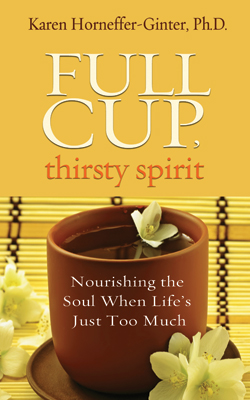|
|
|
Full Cup, Thirsty Spirit: The Ache Of Being
by Karen Horneffer-Ginter, Ph.D.
 The rush and pressure of modern life are a form, perhaps the most common form, of its innate violence. The rush and pressure of modern life are a form, perhaps the most common form, of its innate violence.
Thomas Merton
So often, I hear clients lamenting: “I’ve just had so much going on—I haven’t had a moment to catch my breath.” And it’s likely that we’ll find ourselves speaking such words—and searching for our own getaway—at one time or another, as we balance the demands of adulthood. Often the more successful we are at carving out a life with meaningful activities and relationships, the more likely we are to get overwhelmed by the demands of all that we’ve created.
It seems this predicament is an inevitable cost that comes from being effective at filling our lives with engagements and commitments. I’m not quite sure why it has to be this way, but I’ve seen it in my own life as well as in the lives of many people I counsel and teach. The schedules we create with the best of intentions often become too much to bear, and we end up feeling like the sunflowers of late summer, slumped over by the size and heaviness of all that’s resting on our shoulders. As Merton’s words suggest, we become victims of a self-created violence.
This dynamic can be hard to spot at first, especially if our life’s cup is overflowing with good things. It’s easier to see and feel the need to slow down and fill up when life is difficult. Either way, however, the qualities of busyness and too much–ness can create an ache in our souls based on their sheer volume. They can keep us from hearing our own wisdom to know what needs to happen in our lives and inside ourselves. They can also leave us feeling disconnected from a sense of gratitude for the things that, deep down, we feel grateful for.
What we need most during these times is to turn our attention within and replenish. We need the very thing that often feels the farthest away. Finding time to slow down can be an obstacle, no question. However, I’ve come to see that not knowing how and where to begin is often an even greater challenge.
Along with discovering how to create such pit stops for ourselves when we most need them, other shifts are sometimes required if we want to bring our lives into balance and sustain these changes over time. These shifts include reconnecting with what matters most, bringing this awareness into our everyday lives, accessing humor and playfulness when we can, and being present with life’s challenges when we must.
The Art of Slowing Down
One key to taking care of ourselves lies in learning how to slow down. I have a friend who’s in the middle of a well-deserved sabbatical. These months represent the first chance she’s had in two decades to unwind a bit as a working, single mom. “It’s just incredible,” she remarked, “having time to exercise and read and cook meals and walk outside—it’s really unbelievable.”
“I’m curious,” I asked her. “What’s the best part: the exercising, the reading, the cooking, or the walking?” Without hesitation she replied, “Just having time—that’s all. I’ve never gotten to slow down before and it’s liberating.”
Although few of us are graced with the chance to have a sabbatical, most of us could greatly benefit from the opportunity to have more space and time in life so that slowing down could be an option. We live in a culture of speed, and although I’ve always known this, it became especially apparent to me several years ago when I traveled to Bali. Within the first day of being there, I found myself awestruck by the Balinese pace of life. I watched them as though they were some rare species, feeling puzzled by the sight of humans moving without rushing. I had never seen people engage in daily tasks without a sense of needing to get on to the next thing.
It also became apparent that they didn’t seem to worry in nearly the way I was accustomed to seeing. As opposed to holding tension in their bodies, they carried a quality of lightness and a radiant smile. I commented to a Balinese priest about how people in our country tend to pray, and then worry, and then continue rushing in response to their worry—but people in their country seem to just pray. He confirmed my sense that they actually trust in their prayers.
I realize that my fascination with the Balinese lack of rushing and worrying is based on my own life story. From a young age, my mind has known how to worry and my body has known how to rush with impeccable skill and familiarity. I would say that I was born with these abilities, but I know that technically this isn’t possible. Maybe it’s more fair to say that somewhere between my first breath and the time I graduated from elementary school these ways of being had become second nature. I could perform them with the ease of a rodeo cowboy spinning his lasso in all directions and with the automatic reflex of a short-order cook flipping dozens of burgers on a grill. My successes at speed were rewarded from a young age: setting records in the 50-yard dash and bringing home certificates that boasted of how many times I could jump rope in ten minutes. I excelled at speed reading and quickly learned that the faster I got homework done, well, the faster it got done.
Even while being on vacation in Bali, having no need to be in a hurry, I found myself still feeling like a rusher in contrast to these people. Our first night out to dinner, as we were finishing our desserts, my husband asked for the check. Our waiter paused and turned to us with a puzzled look on his face. “Why you in such a hurry?” My first thought was, Because, sir, this is what my people do. But instead of speaking these words, I shrugged my shoulders and half-motioned to our children as though they were the root cause.
I realized how adamant I was to protect the Balinese pace of life as we were driving to the airport to leave the island. We passed a billboard for McDonald’s that read: “Buru Buru?” and showed a picture of a cheeseburger. The presence of the restaurant, alone, felt wrong to me, but then I made the mistake of asking our taxi driver, “What does buru buru mean?”“Ahh,” he said, “it means ‘in a hurry.’” I screamed, “No!” so loudly that I startled him. “Don’t let them take over your land. No buru buru . . . resist the buru buru!”
I realize that my passionate outcry came from knowing the sort of suffering that comes from rushing and experiencing how hard it is to convert to being a nonrusher once the art of moving quickly has been perfected. For me, it’s an ongoing journey of catching myself when I’m moving too fast.
Excerpted from the book Full Cup, Thirsty Spirit: Nourishing the Soul When Life's Just Too Much, It is published by Hay House ©2012 and available at all bookstores or online at: www.hayhouse.com.

Karen Horneffer-Ginter has been practicing psychology and teaching yoga and contemplative practices for more than 16 years. She has also taught graduate students and health-care professionals, along with directing a university-based holistic health-care program, and co-founding the Center for Psychotherapy and Wellness in Kalamazoo, Michigan. For more information, please visit www.fullcupthirstyspirit.com or www.karenhg.com.
|

